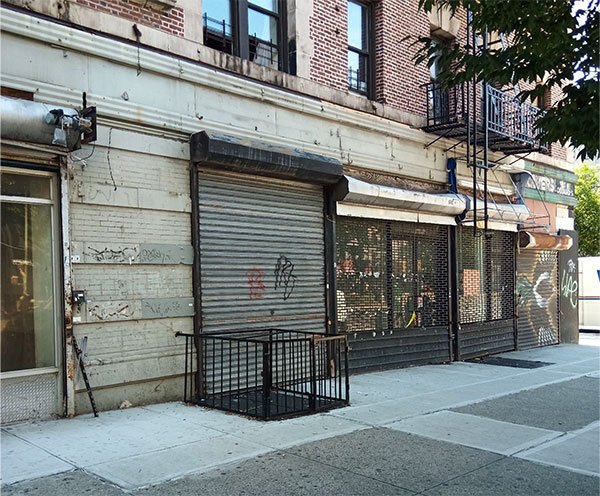
Closed storefronts (photo: Office of Manhattan Borough President)
Occupied storefronts in New York City make neighborhoods lively, convenient, and livable. But there is a big difference between thriving retail and retail vacancy. When metal grilles and empty spaces dominate, ground-floor retail becomes a community and citywide liability. Vacant stores are ugly, make people feel less safe, attract graffiti, and fail to offer needed neighborhood services.
Even before the pandemic, many neighborhoods were blighted by excessive rates of vacancy, much of it driven by unrealistic rent levels as landlords held out for a bigger payday. In 2019, there were 5,313 reported ground-level vacancies in Manhattan, which roughly equate to 31.2 million square feet of space.
The pandemic, the shift to work-from-home for many employees, and the dominance of online ordering have since generated an even greater retail collapse and rising vacancy crisis. The spreading ugliness stands in the way of a full recovery, including both traditional business districts and many mixed-use residential neighborhoods.
Mayor Adams and many civic and business leaders are concerned about this growing retail blight but have so far offered few solutions beyond encouraging employers to force workers back into Manhattan offices. But with many chain retailers and small food retailers shuttered, returning to work and socializing on coffee and lunch breaks has become even less attractive in office districts. Attracting substantial new retail back to many other neighborhoods also remains challenging given stubbornly high unemployment, high rents, and cheaper online shopping options.
A team of architects (Michael Meredith, Hilary Sample, and their studio MOS) have explored retail vacancy in their book Vacant Spaces NY (New York: ACTAR, 2020), and discovered many high-impact opportunities for adaptive reuse.
They have demonstrated that rethinking retail in Manhattan neighborhoods, where available housing is typically limited, represents a great opportunity for both neighborhood reinvestment and quality housing. Rethinking retail is a worthwhile addition to Mayor Adams’ "City of Yes" planning initiative that calls for eliminating "obstacles to repurposing space, allowing the city’s businesses and economy to evolve over time."
A conservative estimate of retail vacancies reveals that converted retail spaces in Manhattan alone could easily provide housing for over 125,000 residents (about 100,000 micro units or 35,000 two-bedrooms, for example). Further study is needed to determine specific scenarios, but the city and state need to think about incentives for conversion of retail space into desperately needed housing resources.
Affordable live/work opportunities abound in vacant retail, providing opportunities for studios and for stores in front and housing in back. Larger commercial spaces can be subdivided and redesigned for supportive or even market-rate housing, particularly in areas where ground floor retail has no upper stories (thus providing opportunities for courtyards to add light and air to apartments).
Vacant retail can also be turned into high-value community spaces including libraries, senior centers, cooling centers, childcare services, after-school programs, and community centers. Overcrowded schools could use retail space as annexes for student activities including libraries, art studios, and vocational training. The city could develop secure public bike parking, rented at an hourly rate, for the growing legions of bike commuters. Many empty stores could be rented and redesigned as the location of new public restrooms city leaders are advocating. Branches of city agencies could be set up in some retail spaces close to where people live and work, including Health + Hospitals neighborhood clinics.
We acknowledge that there are challenges to adaptive reuse. The process for a change of use would need to be made easier to obtain in the case of owner-occupied use (zoning and Department of Buildings applications). For residential space, some flexibility in the building codes might be required to make retail spaces work for housing. Adaptive reuse of ground-floor retail is nevertheless far less daunting compared to converting traditional office buildings to affordable housing.
The smaller scale of individual retail conversion projects and the flexibility possible for different uses opens a world of civic possibilities.
***
Hilary Sample is the IDC Professor of Housing Design at Columbia University (GSAPP) and Co-Founder of the New York-based architecture and design studio MOS. Nicholas Dagen Bloom is Professor of Urban Policy and Planning at Hunter College and author of many books on housing and planning.
***
Have an op-ed idea or submission for Gotham Gazette? Email This email address is being protected from spambots. You need JavaScript enabled to view it.